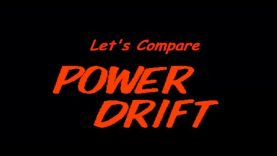Let’s Compare ( Bump ‘n’ Jump )
Gaming History Source
Video Locations:
Arcade 0:14
Atari 2600 1:42
commodore 64 ( Burnin Rubber ) 3:11
Commodore 64 ( Bumping Buggies ) 4:29
Intellivision 6:07
Colecovision 7:36
NES 9:04
End 10:33
Description Source:
http://en.wikipedia.org/wiki/Bump_’n’_Jump
Bump ‘n’ Jump, known in Japan as Burnin’ Rubber (バーニンラバー?), is a 1982 Japanese arcade game created by Data East Corporation for its DECO Cassette System. The game was also published by Bally Midway.
In Bump ‘n’ Jump, the girlfriend of the protagonist has been kidnapped by the Black Army Corps, and he must race to save her. The goal in is to drive from the beginning of a level to the end while bumping enemy vehicles into obstacles and jumping over various large obstacles such as overpasses, and large rivers.
Gameplay
Due to the bird’s eye view, players cannot see the large obstacles until it is too late to jump, so the game displays a flashing exclamation point when the large obstacles are about to appear. Adding a level of complexity, the NES version of the game also requires that players pick up cans of gasoline that are interspersed throughout each course, as their car uses up fuel steadily throughout the game.
The enemy vehicles are separated into cars and trucks. Cars can be bumped into obstacles or jumped upon and destroyed, while trucks cannot be bumped; they can be jumped upon only to destroy them, and will sometimes drop obstacles that will destroy the player. At the end of each level players receive bonus points for the remaining gasoline in their car, and the number of enemy vehicles crashed. Going from one level to another is characterised by a change of seasons. Apart from the change of scenery, the winter scenario also features the additional challenge of slippery roads. Players get points for bumping other cars and causing the other cars to crash, but one bonus isn’t apparent: If the player completes a level without bumping another car, the player receives a huge point bonus. The C64 version uses the chorale parts of Johann Sebastian Bach’s Herz und Mund und Tat und Leben cantata for the soundtrack.













